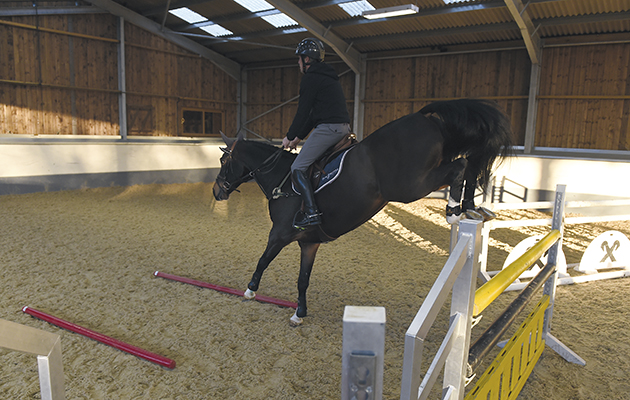The Irish showjumper shares his top exercise for helping to keep your horse straight to a fence — handy preparation for jumping in indoor arenas this winter, where horses can be easily distracted
Jumping indoors is an environment that can quickly throw the spotlight on any underlying schooling issues. Space can be tight and if your horse isn’t responsive to the aids, problems can quickly mount.
Having a horse that is responsive off the aids is also crucial for tackling some of the distractions you can encounter jumping inside. “If you have a horse who can be spooky then it’s not just the fences that can be a problem, it’s also what’s around them,” Shane says.
Shane’s exercise to improve your straightness
- This exercise essentially uses poles as funnels to keep the horse straight down a related distance. It’s useful for both young horses, who tend to naturally drift, and for keeping accuracy with more established ones.
- Shane believes honing straightness is a handy preparation for jumping in indoor arenas, where horses can be easily distracted.
- “If your horse tends to drift and you’re going down a line in an indoor arena, and there’s a banner or something that catches his eye, he’ll end up drifting further. By the time the second obstacle is on top of you, you’ll be trying to pull the horse back in to the jump,” Shane says.
- “The distractions will be there anyway but if the horse routinely concentrates on straightness then he shouldn’t deviate off line so much.”
Continued below…

Keen to improve your horse’s jump? Shane Breen swears by this simple exercise
The Irish showjumper takes us through a step-by-step guide to an exercise designed to get the most out of your
The ultimate Whitaker quiz: have you got the legendary showjumping family sussed?
You'd be excused for getting your Whitakers in a muddle from time to time. Britain's showjumping dynasty seems to be
Step-by-step guide
- Set up two verticals five strides (22 yards) apart — you can experiment with the distance but five strides is enough space to show up if your horse isn’t straight.
- On the take off and landing side of each vertical, lay two foam poles at right angles to the fence to guide the horse straight, making a “tunnel” for them to go through.

- Keep the poles quite wide apart with young horses as they tend to drift naturally.

- Using foam poles is safer than solid poles — if the horse does step sideways then he is less likely to wrench any joints.
- Young horses can be quite surprised by the layout, so if you’re doing the exercise for the first time, start with a pole on the ground rather than a fence and build up gradually.
This article was first published in the 22 December 2016 issue of Horse & Hound magazine
For all the latest equestrian news and reports, don’t miss Horse & Hound magazine out every Thursday





